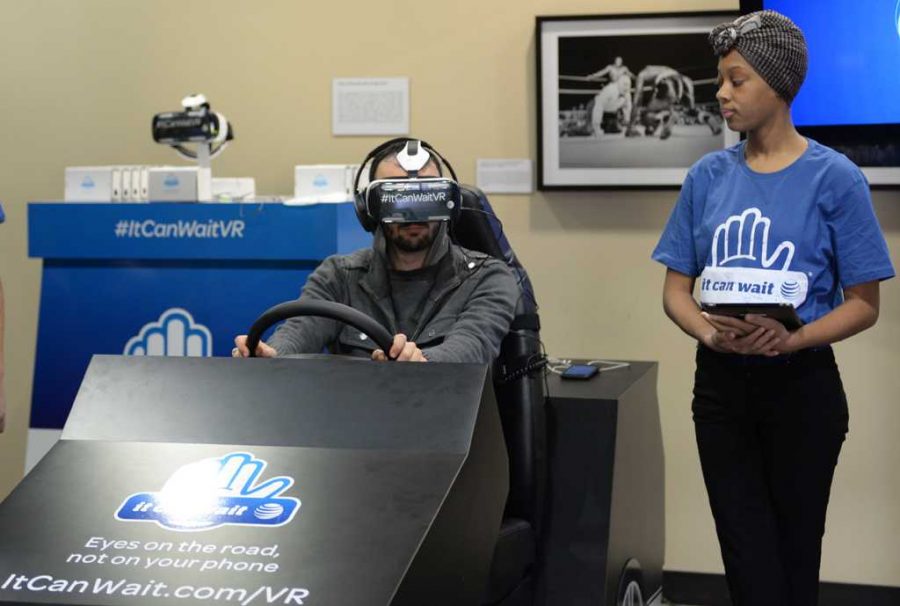Students rolled through stop signs and nearly hit bicyclists in an indoor texting-and-driving simulation Friday in Posvar Hall for AT&T’s It Can Wait campaign.
The company partnered with the Phi Delta Theta social fraternity to bring a virtual reality texting-and-driving simulator to the first floor of Posvar Hall and raise awareness about the dangers of distracted driving.
From 12 to 4 p.m., the program attracted a steady stream of curious students taking turns using the simulator, which used virtual reality technology to simulate a fatal accident with another car.
Cell phones distract about 660,000 American drivers at any moment, endangering drivers, passengers and other people on the road, according to Distraction.gov, the U.S. Government website for distracted driving.
According to Doug Steeber, a Phi Delta Theta brother, an AT&T representative approached the fraternity and asked the brothers to host and event to spread the “It can wait” message, which urges drivers to turn off their phones or use airplane mode while operating vehicles to avoid accidents.
Doug Steeber, a senior psychology major and Phi Delta Theta brother, said interacting with people at the event revealed the tangible effects of texting and driving.
“I’ve met two people who were victims of texting and driving in the last 30 minutes,” Steeber said, speaking of attendees he talked to at the event.
Steeber said the fraternity agreed to help host AT&T’s simulation because they wanted to help out the Pitt community.
“Texting and driving is incredibly dangerous,” Steeber said. “People think, ‘It can’t happen to me,’ until it does. Any time you take your eyes off the road, it can be a deadly mistake.”
Though the model car students sat on while participating was made of cardboard — complete with stickers to represent the speedometer and the temperature gauge — the simulation itself used cutting-edge technology from virtual reality device manufacturer Oculus Rift.
Participants strapped on virtual reality goggles and headphones, cutting off their sensory connection to the outside world and immersing themselves in the simulation. The goggles simulate 360 degrees of vision — when users move their heads, the camera moves with it, simulating normal vision.
The simulation put users in the driver’s seat, interrupting their concentration with text messages from friends and family members. Each time the user gets a text, the simulation has the driver look at the cell phone, which ultimately results in the user getting T-boned by a red sports car.
As it hits them, time slows to a crawl — glass shards float through the air in slow motion and the camera suddenly shifts, giving the user the impression they are hovering above the wreck, looking down at the mangled mess that used to be their vehicle. The scene fades.
Though the simulation ends and users can take off their goggles and walk home safely, it represents a real ending for many drivers and passengers. In 2013, distracted drivers killed 3,154 people, according to Distraction.
According to Jim Penna, director of external affairs for AT&T, the national campaign’s virtual reality tour began last summer.
Penna said texting and driving is so dangerous because, to drivers, glancing downward for a few seconds seems inconsequential.
“People feel a compulsion to answer texts — they might think they’re being rude, or it might be curiosity,” Penna said. “People think they’re bulletproof.”
Penna said it’s especially important that the campaign’s message reaches the young adult age group.
According to the Department of Transportation, 27 percent of distracted driver fatal crashes involve drivers in their 20s.
Alex Dawson, a first-year computer science major, said the simulation can make people think twice about texting and driving.
“Most of my friends text and drive. Snapchatting and driving is probably the most common,” Dawson said.
Dawson said the simulation scared him, which, according to Penna, is part of its goal.
Penna said the simulation targets the young adult audience, hoping to emphasize how unimportant text messages are in comparison with human lives.
“It’s about raising awareness,” Penna said. “Pick the silliest text you got yesterday — a joke, a meme, whatever it is — and ask yourself, ‘Is opening that really worth your life?’”



